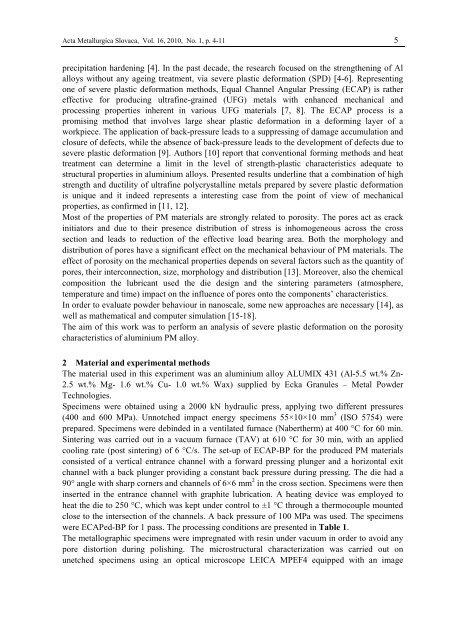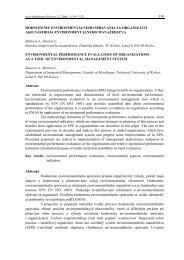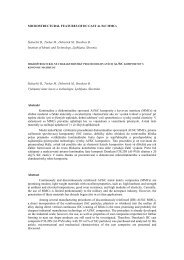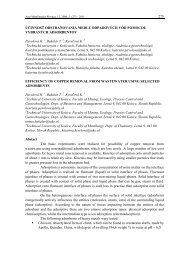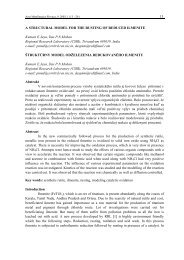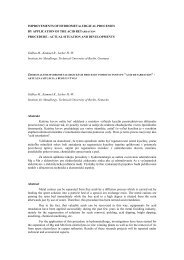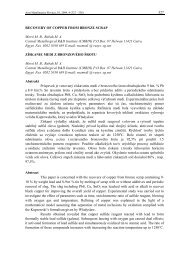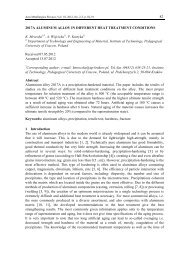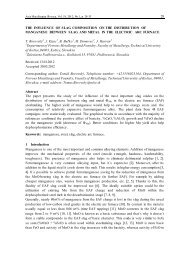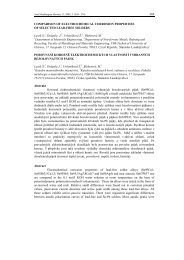4 EFFECT OF SEVERE PLASTIC DEFORMATION ON THE ...
4 EFFECT OF SEVERE PLASTIC DEFORMATION ON THE ...
4 EFFECT OF SEVERE PLASTIC DEFORMATION ON THE ...
You also want an ePaper? Increase the reach of your titles
YUMPU automatically turns print PDFs into web optimized ePapers that Google loves.
Acta Metallurgica Slovaca, Vol. 16, 2010, No. 1, p. 4-11 5precipitation hardening [4]. In the past decade, the research focused on the strengthening of Alalloys without any ageing treatment, via severe plastic deformation (SPD) [4-6]. Representingone of severe plastic deformation methods, Equal Channel Angular Pressing (ECAP) is rathereffective for producing ultrafine-grained (UFG) metals with enhanced mechanical andprocessing properties inherent in various UFG materials [7, 8]. The ECAP process is apromising method that involves large shear plastic deformation in a deforming layer of aworkpiece. The application of back-pressure leads to a suppressing of damage accumulation andclosure of defects, while the absence of back-pressure leads to the development of defects due tosevere plastic deformation [9]. Authors [10] report that conventional forming methods and heattreatment can determine a limit in the level of strength-plastic characteristics adequate tostructural properties in aluminium alloys. Presented results underline that a combination of highstrength and ductility of ultrafine polycrystalline metals prepared by severe plastic deformationis unique and it indeed represents a interesting case from the point of view of mechanicalproperties, as confirmed in [11, 12].Most of the properties of PM materials are strongly related to porosity. The pores act as crackinitiators and due to their presence distribution of stress is inhomogeneous across the crosssection and leads to reduction of the effective load bearing area. Both the morphology anddistribution of pores have a significant effect on the mechanical behaviour of PM materials. Theeffect of porosity on the mechanical properties depends on several factors such as the quantity ofpores, their interconnection, size, morphology and distribution [13]. Moreover, also the chemicalcomposition the lubricant used the die design and the sintering parameters (atmosphere,temperature and time) impact on the influence of pores onto the components’ characteristics.In order to evaluate powder behaviour in nanoscale, some new approaches are necessary [14], aswell as mathematical and computer simulation [15-18].The aim of this work was to perform an analysis of severe plastic deformation on the porositycharacteristics of aluminium PM alloy.2 Material and experimental methodsThe material used in this experiment was an aluminium alloy ALUMIX 431 (Al-5.5 wt.% Zn-2.5 wt.% Mg- 1.6 wt.% Cu- 1.0 wt.% Wax) supplied by Ecka Granules – Metal PowderTechnologies.Specimens were obtained using a 2000 kN hydraulic press, applying two different pressures(400 and 600 MPa). Unnotched impact energy specimens 55×10×10 mm 3 (ISO 5754) wereprepared. Specimens were debinded in a ventilated furnace (Nabertherm) at 400 °C for 60 min.Sintering was carried out in a vacuum furnace (TAV) at 610 °C for 30 min, with an appliedcooling rate (post sintering) of 6 °C/s. The set-up of ECAP-BP for the produced PM materialsconsisted of a vertical entrance channel with a forward pressing plunger and a horizontal exitchannel with a back plunger providing a constant back pressure during pressing. The die had a90° angle with sharp corners and channels of 6×6 mm 2 in the cross section. Specimens were theninserted in the entrance channel with graphite lubrication. A heating device was employed toheat the die to 250 °C, which was kept under control to ±1 °C through a thermocouple mountedclose to the intersection of the channels. A back pressure of 100 MPa was used. The specimenswere ECAPed-BP for 1 pass. The processing conditions are presented in Table 1.The metallographic specimens were impregnated with resin under vacuum in order to avoid anypore distortion during polishing. The microstructural characterization was carried out onunetched specimens using an optical microscope LEICA MPEF4 equipped with an image


